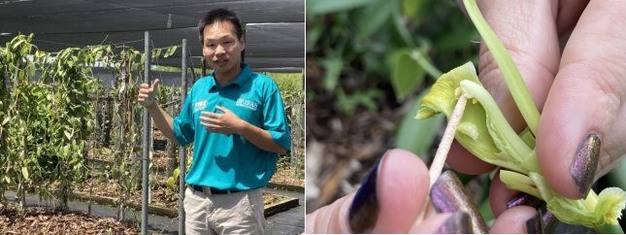Florida is on the cusp of a new agricultural crop that could give small farmers in the southern region of the state a high-value alternative to vegetable and fruit production.
University of Florida researchers at the Tropical Research and Education Center have embarked on a comprehensive evaluation of vanilla – from developing fertilizer recommendations to developing the highest-yielding and disease-resistant varieties to identifying beans with the best vanilla content.

“Why grow vanilla? It’s the world’s most popular flavor,” emphasized Edward “Gilly” Evans, University of Florida food and resource economist and director of the center. “Vanilla extract can command anywhere from $250 to $600 per kilo. By value of acreage, it has the potential to outcompete all other crops we grow in this area.”
Vanilla, a vining orchid, is mainly grown in Madagascar. The U.S. is the world’s No. 1 importer of vanilla beans, which are then processed stateside and used for food, flavor, cosmetics, perfumes, and medicinal purposes.
University of Florida’s vanilla breeding program began in 2017 when researchers recognized economic, infrastructure, and environmental changes that were putting pressure on small farmers – challenges such as rising costs of ag inputs, foreign competition, increased environmental and labor regulations, and an erosion of market power. Researchers were jolted into finding viable alternative crop enterprises.
Spearheaded by former University of Florida plant breeder Alan Chambers, the center began a modest vanilla plant germplasm collection, which today has ballooned into over 400 accessions and 27 species, including five species native to Florida.
Xingbo Wu, a University of Florida plant breeder and geneticist, and his colleagues have carried on Chambers’ work through a $383,000 Southern Sustainable Agriculture Research and Education (SSARE) grant and a $16,499 SSARE Graduate Student Grant to explore establishing domestic vanilla cultivation in southern Florida, Puerto Rico, and the U.S. Virgin Islands.
“We are looking at several different objectives: identifying varieties with high yields, disease resistance, and high vanilla content; identifying nutrient content in plants to develop best fertilizer recommendations; and identifying potential plant pollinators,” said Wu.
One aspect of the research is a nitrogen rate study and nutrient analysis of the stems, leaves, and roots to develop the best fertilizer recommendations to meet the plant’s nutritional demands. Horticulture Ph.D. student Jesse Potts is conducting fertilizer experiments on vanilla plants in containers.
“We don’t know the fertilizer rate vanilla needs,” said Potts. “So I want to find out the efficacy of conventional and organic fertilizer rates on vanilla by applying various rates of balanced fertilizer to container plants and measuring the plant growth rates to determine the optimal fertilization regime.”
Dr. Vance Owens, the NIFA national program leader who provides guidance to SARE, said projects like this, where researchers see possibilities rather than limitations, are a hallmark of the SARE program.
“The University of Florida researchers were looking for crop alternatives for producers growing in tropical climates,” Owens said. “Growing vanilla on the farm in the United States offered possibilities and opportunities that others might have discounted. These scientists looked at vanilla and said why not? And their openness to innovation may be the key to establishing a vanilla industry here.”
Researchers are also exploring ways to pollinate vanilla plants, which is labor intensive. Due to the unique reproductive structure of the flower, vanilla plants are hand-pollinated.
“We think there are pollinators that pollinate the vanilla plant, but we haven’t identified them yet,” said Wu. “We know this because native vanilla plants growing wild in Florida, which vine high up in trees, produce vanilla beans. So something is pollinating them.”
In a side experiment, researchers set cameras in trees in a native vanilla production area and captured over 10,000 images before a hurricane destroyed the area in 2022. The images have yet to be processed.
Researchers are also exploring virus-induced gene silencing to increase a vanilla plant’s tolerance to disease, which can be prolific. Vanilla is susceptible to many fungal diseases and various root, stem, and leaf rots, in addition to viruses.
“The biggest challenge inhibiting domestic vanilla production has been the lack of appropriate planting material and scientifically validated growing information,” said Wu. “The emerging domestic vanilla market requires a supply chain to move product efficiently from farm to end users. This project was designed to overcome these challenges and could have major impacts on productivity, profitability, and rural communities.”
So far, approximately 11 small farmers in the Homestead area are growing vanilla.
Source: usda.gov










